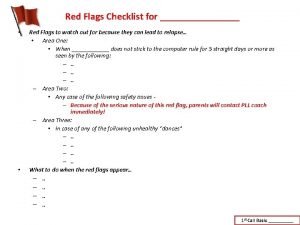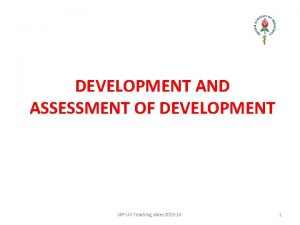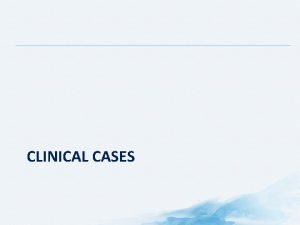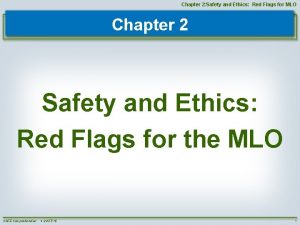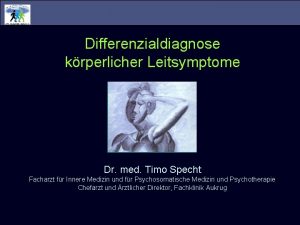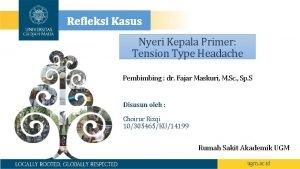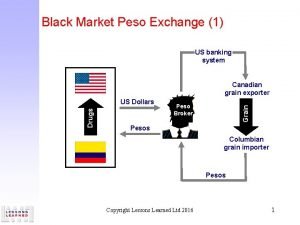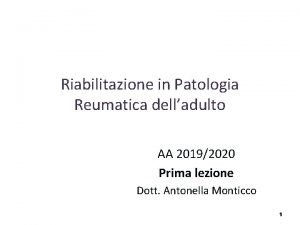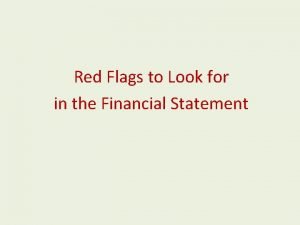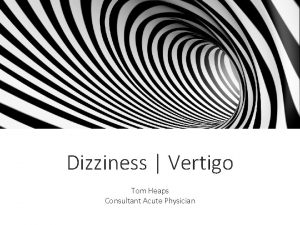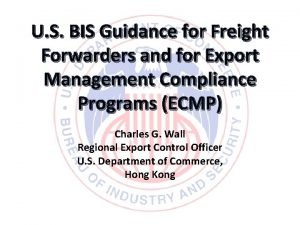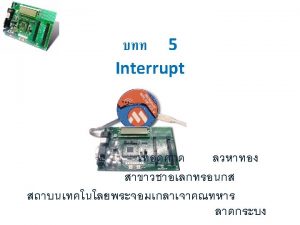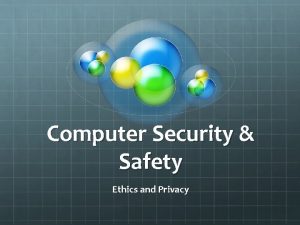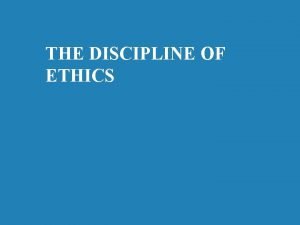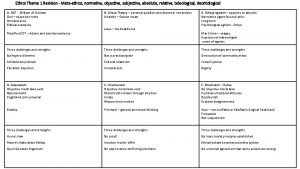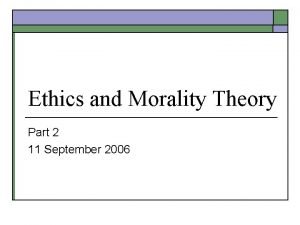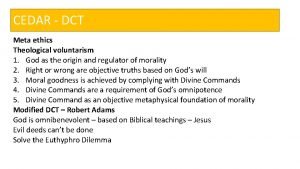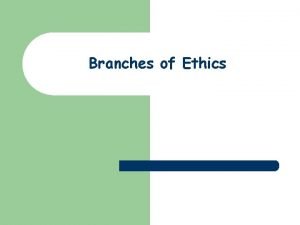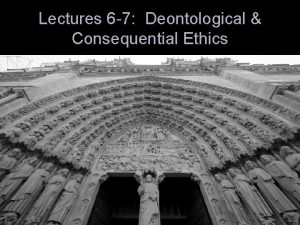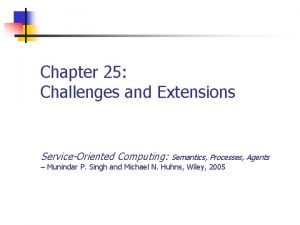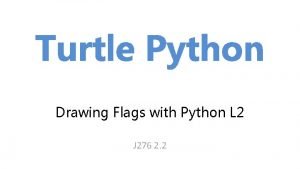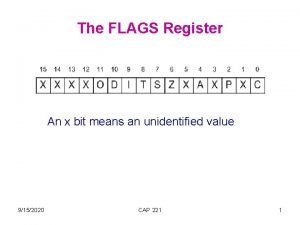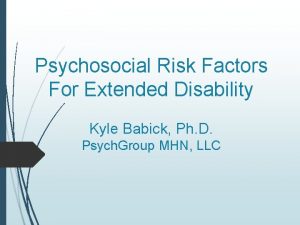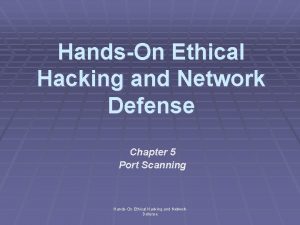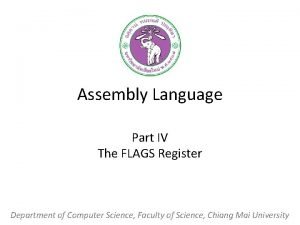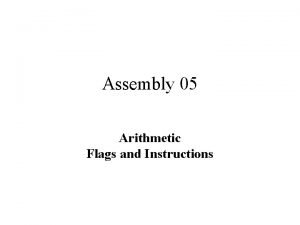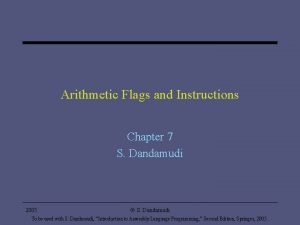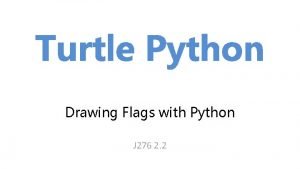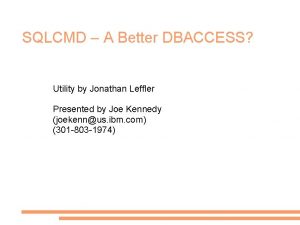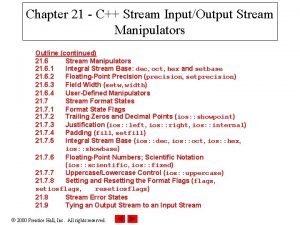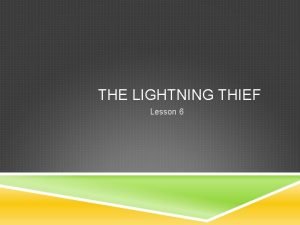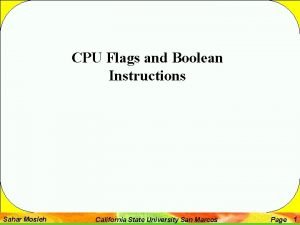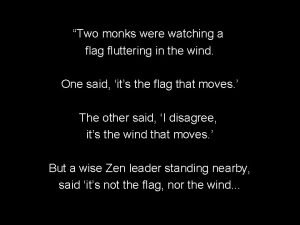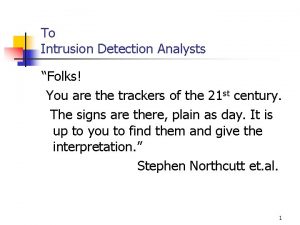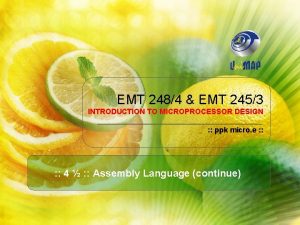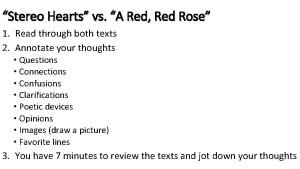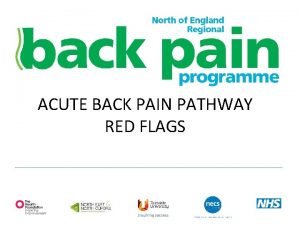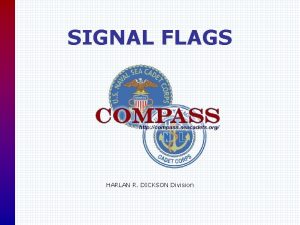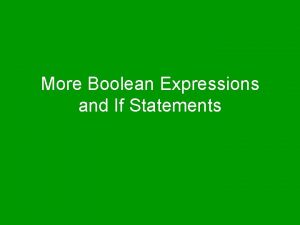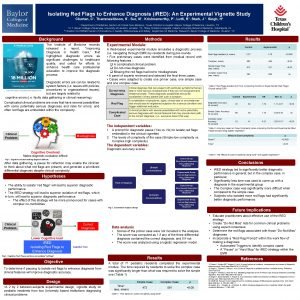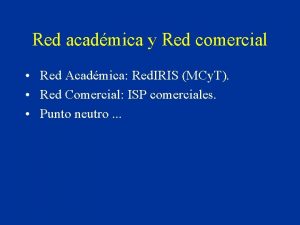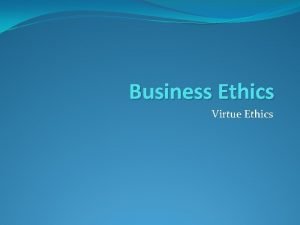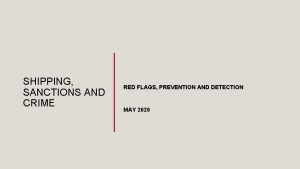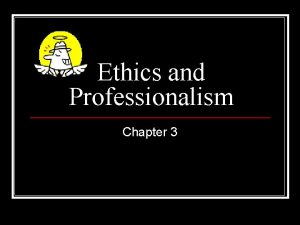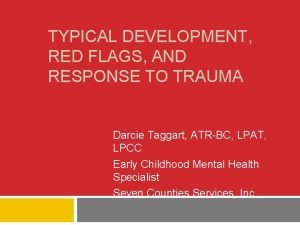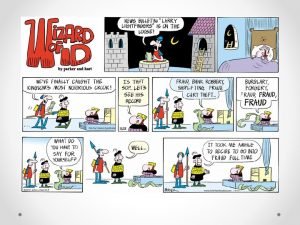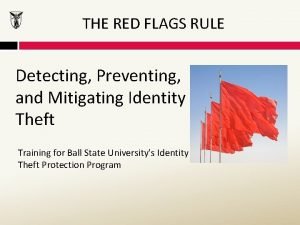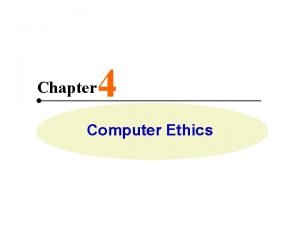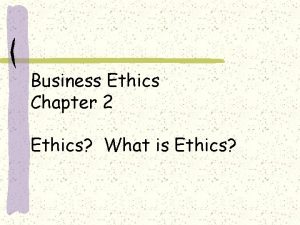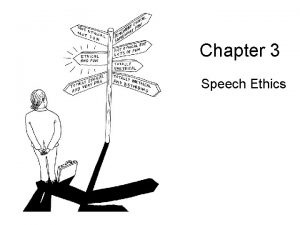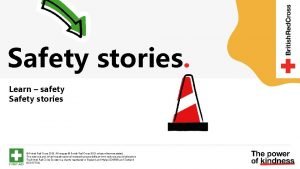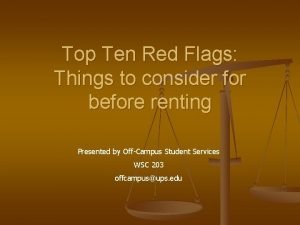Chapter 2 Safety and Ethics Red Flags for































































- Slides: 63

Chapter 2: Safety and Ethics: Red Flags for MLO Chapter 2 Safety and Ethics: Red Flags for the MLO SAFE Comprehensive: ● 02/27/15 1

Chapter 2: Safety and Ethics: Red Flags for MLO Disclaimer • Disclaimer: Names of all persons, companies, and entities in any documented example have been changed. Therefore, if further research is desired, names will differ in the actual case law from that presented within the course. • If further research is desired in regards to specific case law, research is best performed by visiting each specific state’s department of financial institutions website. Each state may use varying versions of this department name. Some case law may be easily researched and other states are extremely protective of case law and extended research may be required. As an example, to research Florida case law, first visit the Florida Office of Financial Regulation website and proceed to the Final Administrative Actions page where a search engine will be presented. For California, the Consumer Affairs agency must be selected from their state website (www. ca. gov). Researchers must then move through the following pages, Licenses, Press Release, and Board of Real Estate to arrive at the Disciplinary Actions page to research the case law. SAFE Comprehensive: ● 02/27/15 2

Chapter 2: Safety and Ethics: Red Flags for MLO Key Terms • Arm’s Length Transaction • Home Ownership Equity Protection Act (HEOPA) • Housing and Economic Recovery Act of 2008 (HERA) • Mortgage Disclosure Improvement Act (MDIA) • Predatory Lending SAFE Comprehensive: ● 02/27/15 Refer to page 33 3

Chapter 2: Safety and Ethics: Red Flags for MLO To Be Ethical • Lawfully and thoroughly catalog all important documentation • Adhere to a code of ethics from a professional organization • Serve the mortgage lending needs of the public in an ethical manner • Treat everyone equally • Instill honesty in every action • Never use authority to take advantage of people • Give full disclosure about all terms and conditions of the mortgage loan SAFE Comprehensive: ● 02/27/15 Refer to page 34 4

Chapter 2: Safety and Ethics: Red Flags for MLO Code of Ethics Provided by the National Association of Mortgage Professionals • Honesty and Integrity • Professional Conduct • Honesty in Advertising • Confidentiality • Compliance with Law • Disclosure of Financial Interests SAFE Comprehensive: ● 02/27/15 Refer to page 34 5

Chapter 2: Safety and Ethics: Red Flags for MLO The Informed MLO - Sources • The Consumer Financial Protection Bureau (CFPB) • Federal National Mortgage Association (FNMA) • Federal Home Loan Mortgage Corporation (Freddie Mac) • Housing and Urban Development (HUD) • Veteran’s Administration (VA) Loans • State Regulatory Agencies SAFE Comprehensive: ● 02/27/15 Refer to page 35 & 36 6

Chapter 2: Safety and Ethics: Red Flags for MLO Knowledge Check 1. A MLO acts in an ethical manner by adhering to all of the following actions EXCEPT A. allowing a borrower to change the terms of the loan. B. being honest with clients and lenders. C. charging a higher interest rate to a minority borrower. D. treating everyone in an equal manner. SAFE Comprehensive: ● 02/27/15 Refer to page 37 7

Chapter 2: Safety and Ethics: Red Flags for MLO Knowledge Check 2. On the website for HUD, a loan originator can locate all of the information listed below EXCEPT A. disciplinary actions taken by a state regulatory agency against a MLO. B. the FHA National Mortgage Limit list. C. HUD-approved condominium projects. D. HUD-approved counseling agencies. SAFE Comprehensive: ● 02/27/15 Refer to page 37 8

Chapter 2: Safety and Ethics: Red Flags for MLO Knowledge Check 3. The underwriting manual for FHA forward insured loans and programs is also titled A. 203 B. B. 4155. 1. C. HUD Clips. D. Section 8. SAFE Comprehensive: ● 02/27/15 Refer to page 37 9

Chapter 2: Safety and Ethics: Red Flags for MLO Continuing Training A successful MLO seeks education and training that exceeds the national requirement of the annual 8 hours of continuing education required by the NMLS. • Traditional Education • Mentoring SAFE Comprehensive: ● 02/27/15 Refer to page 37 & 38 10

Chapter 2: Safety and Ethics: Red Flags for MLO Crime and Reputation • Deception is the act of convincing an individual of a falsehood or untruth. • Fraud is an intentional misrepresentation of the truth or facts for the sole intent to rob an individual of a right or possession. • Criminal fraud is any fraud that injures an individual as a result of the action. SAFE Comprehensive: ● 02/27/15 Refer to page 38 11

Chapter 2: Safety and Ethics: Red Flags for MLO Criminal Actions that Financially Impact Consumers • “Steers” borrower into a higher interest rate, which costs a continuing monthly sum of money • Commits mortgage fraud by inflating consumer charges on GFE • Fails to notify/disclose changed circumstances that have an impact on the fees paid at closing or monthly payment amounts • Engages in illegal, improper, deceptive, or fraudulent business practices that cause harm to the consumer SAFE Comprehensive: ● 02/27/15 Refer to page 38 & 39 12

Chapter 2: Safety and Ethics: Red Flags for MLO Case Study ABC Loan Corporation 1. ABC Loan Corporation was accused of violating which regulation? 2. How did ABC Loan Corporation violate this regulation? 3. How did the actions of ABC Loan Corporation cause harm to the consumer, sometimes without the consumer’s knowledge? 4. Today, MLO compensation is regulated by an amendment to which federal regulation? SAFE Comprehensive: ● 02/27/15 Refer to page 40 13

Chapter 2: Safety and Ethics: Red Flags for MLO Criminal Actions that Financially Impact Employers • Violating the timeframes set by TILA and RESPA for proper disclosure to the consumer • Advertising violations • Failure to provide required information to processing/underwriting • Failing to submit loan files for processing and review in a timely manner SAFE Comprehensive: ● 02/27/15 Refer to page 40 14

Chapter 2: Safety and Ethics: Red Flags for MLO Criminal Actions that Financially Impact Mortgage Loan Parties • By the creditor • By the mortgage broker/banker/correspondent • By surrounding homeowners • To private mortgage insurers • To FHA, VA or USDA SAFE Comprehensive: ● 02/27/15 Refer to page 41 15

Chapter 2: Safety and Ethics: Red Flags for MLO Avoid Common Licensee Mistakes • Cautiously scrutinize all borrowers and the documentation that is provided • Qualify the borrower in advance with a thorough conversation with the borrower regarding the Four “C’s” of credit. Ask for: – Full names, including middle names – Current residence address and residences for the previous two years – Currental/mortgage payment to determine the amount of payment shock that may occur SAFE Comprehensive: ● 02/27/15 Refer to page 41 & 42 16

Chapter 2: Safety and Ethics: Red Flags for MLO High-level Red Flags • SSN and address discrepancies within the loan file • Verifications addressed to a specific party’s attention • Verifications completed on the same day they were ordered or on weekend/holiday • Documentation includes deletions, correction fluid or other alteration • Numbers on the documentation appear to be “squeezed” due to alteration • Different handwriting or type styles within a document • Excessive number of AUS submissions SAFE Comprehensive: ● 02/27/15 Refer to page 42 & 43 17

Chapter 2: Safety and Ethics: Red Flags for MLO Mortgage Application Red Flags • Significant or contradictory changes from handwritten to typed application • Unsigned or undated application • Employer’s address shown only as a post office box • Loan purpose is cash-out refinance on a recently acquired property • Buyer currently resides in subject property • Same telephone number for applicant and employer • Extreme payment shock may signal straw buyer and/or or inflated income • Purchaser of investment property does not own residence SAFE Comprehensive: ● 02/27/15 Refer to page 43 18

Chapter 2: Safety and Ethics: Red Flags for MLO Case Study Fraud for Love 1. What actions did Lou Loan Officer take to ensure that his girlfriend demonstrated the ability to repay the mortgage loan and obtain financing? 2. What actions did Lou Loan Officer take to ensure that his girlfriend appeared to have sufficient assets for down payment and reserves? 3. What measures could Sun. Trust Mortgage have taken to prevent the fraudulent loan? SAFE Comprehensive: ● 02/27/15 Refer to page 43 & 44 19

Chapter 2: Safety and Ethics: Red Flags for MLO Employment & Income Red Flags • Applicant’s job title is generic • Employer’s address is a P O Box, the property address, or applicant’s current residence • Applicant’s residence is (will be) in location remote from employer • Employer name is similar to a party to transaction • Employer unable to be contacted SAFE Comprehensive: ● 02/27/15 Refer to page 44 20

Chapter 2: Safety and Ethics: Red Flags for MLO Employment & Income Red Flags • Year-to-date past-year earnings are even dollar amounts • Withholding not calculated correctly or totals do not flow from pay advice to pay advice • Abnormalities in pay check numbering • Handwritten VOE, pay stubs, or W-2 forms • W-2 form presented is not the employee’s copy • Employer’s ID # has format other than 12 -3456789 • Tax returns not signed or dated • Income appears to be out of line with type of employment • Applicant reports substantial income but has no cash in bank SAFE Comprehensive: ● 02/27/15 Refer to page 44 21

Chapter 2: Safety and Ethics: Red Flags for MLO Case Study Straw Buying Scheme Manny, Moe, Curly, and Shem’s motivation was to help obtain fraudulent loans for straw buyers, and then split the loan proceeds, beginning in 2008. What new regulations, which are part of the Dodd. Frank Act and were implemented in 2014, address the acts that these four engaged in? SAFE Comprehensive: ● 02/27/15 Refer to page 45 22

Chapter 2: Safety and Ethics: Red Flags for MLO Credit Report Red Flags • Difference in names, addresses and birth dates • Superior credit histories; or histories that are not in line with age of applicant • Tri-merge report alerts – recently issued SSN, credit inquiries, new/closed accounts Written verifications of employment, rent, deposits, and sometimes loans (for credit that is not reported on the credit report) should be obtained as independent verifications of the information presented by the borrower. SAFE Comprehensive: ● 02/27/15 Refer to page 45 & 46 23

Chapter 2: Safety and Ethics: Red Flags for MLO Case Study Identity Thieves 1. How did Mickey, Donald, and Ralph assist persons with poor credit histories or criminal records to obtain a “clean slate? ” 2. If the defendants are convicted, what would the maximum penalty be for the alleged crimes? SAFE Comprehensive: ● 02/27/15 Refer to page 46 & 47 24

Chapter 2: Safety and Ethics: Red Flags for MLO Case Study The Worst Call 1. The MLO took an initial loan application on August 28. The borrower stated he was employed as an operations manager. Should the MLO have rejected the application initially? 2. Less than a month later, the MLO is informed by another employee of the lender that the borrower’s employment had been terminated by the employer on August 2, three weeks prior to the initial application. What call should have been made by the MLO? SAFE Comprehensive: ● 02/27/15 Refer to page 48 25

Chapter 2: Safety and Ethics: Red Flags for MLO Case Study The Worst Call 3. Upon hearing of the employment status, the MLO emailed the borrower to discuss the job situation and to request updated paycheck statements. The borrower stated there was an error and asked the MLO to call the Phoenix office (the VOE came from the corporate office in Tucson) and ask for “Adrianne”. Within minutes, the paycheck statements dated 8/15, 9/5, and 9/15 were emailed by the borrower to the MLO. Is it possible to receive paychecks and be terminated/severed from employment? What bothers you about the borrower’s response? SAFE Comprehensive: ● 02/27/15 Refer to page 48 26

Chapter 2: Safety and Ethics: Red Flags for MLO Case Study The Worst Call 4. On September 27, the lender is again informed that the borrower was terminated on August 2. The employer communicated this to the lender both verbally and in writing by re-submitting the Verification of Employment to the lender. Was the former employer at fault in this situation? 5. When the MLO received the information for the second time, he was asked by the processing unit if there was anyone else at the employer’s workplace that could complete a second VOE. What should the MLO have done to properly address the possible fraud? SAFE Comprehensive: ● 02/27/15 Refer to page 48 & 49 27

Chapter 2: Safety and Ethics: Red Flags for MLO Case Study The Worst Call 6. The MLO did not bring the borrower’s loan file to a “hard stop" or request that further work on the file be suspended. Although he did inform the processing supervisor about the discrepancies in the loan file, he failed to bring the information to the attention of the branch manager. He failed to file a suspicious activity report with the branch manager. In paragraph g, there was a lot of activity that could have alleviated a DFI Order and financial repercussions for the employer. What actions could have been taken at this point to address and prevent the fraudulent actions that were taking place? SAFE Comprehensive: ● 02/27/15 Refer to page 49 28

Chapter 2: Safety and Ethics: Red Flags for MLO Case Study The Worst Call 7. The MLO made the phone call to the “inside contact” at the employer and advised processing that he verbally verified the borrower’s employment. He then requested a Verification of Employment be sent to a specific person at the employer as the borrower was “still gainfully employed”; two email addresses were given. This information was also given to the senior loan processor. What are the indicators of a fraudulent loan that are beginning to be discovered? SAFE Comprehensive: ● 02/27/15 Refer to page 49 29

Chapter 2: Safety and Ethics: Red Flags for MLO Case Study The Worst Call 8. What actions of the MLO bother you as a professional mortgage loan originator? 9. Who is responsible for validity of documentation in a loan file? 10. What actions can be taken by the secondary market buyer of the loan in the event of fraud? 11. What actions can be taken by the state regulatory authority against the licensees in a fraudulent mortgage loan scheme? SAFE Comprehensive: ● 02/27/15 Refer to page 50 30

Chapter 2: Safety and Ethics: Red Flags for MLO Asset Documentation Red Flags • Down payment from bank account with no ties to the applicant, does not appear as a withdrawal from applicant’s accounts, cannot be traced back to an account or source, or is made from gifts or from sales transactions • Banking information has no traditional banking history, investment portfolio is concentrated and not diversified, or bank statements are co-owned by unrecognized parties • Bank statements include even dollar amounts, do not identify the applicant, balances significantly higher than the accounts monthly average with no documentation explaining the increase, out-of-sequence dating on bank statements, or inconsistent deposits with the potential borrower’s income SAFE Comprehensive: ● 02/27/15 Refer to page 50 31

Chapter 2: Safety and Ethics: Red Flags for MLO Case Study Cattle Fraud 1. John Wayne, although not involved with a mortgage loan application, committed a common type of asset fraud by: 2. John Wayne could be sentenced to a maximum prison term of _______ and a maximum fine of $ _____, which is the maximum punishment for mortgage fraud. SAFE Comprehensive: ● 02/27/15 Refer to page 51 32

Chapter 2: Safety and Ethics: Red Flags for MLO Owner Occupancy Red Flags Purchase Transactions: • Real estate listed on application however applicant is a renter • Applicant intends to lease current residence • Significant or unrealistic commute distance • Applicant is downgrading from a larger or more expensive house • Sales Contract is subject to an existing lease • Occupancy affidavits reflect applicant does NOT intend to occupy • New homeowner’s insurance is a rental policy SAFE Comprehensive: ● 02/27/15 Refer to page 52 33

Chapter 2: Safety and Ethics: Red Flags for MLO Owner Occupancy Red Flags Refinance Transactions: • Rental property listed on application is more expensive than subject property • Different mailing address on applicant’s bank statements, pay advices, etc. • Different address reported on Credit Report • Significant or unrealistic commute distance • Appraisal reflects vacant or tenant occupancy • Occupancy affidavits reflect applicant does NOT intend to occupy • Homeowner’s insurance is a rental policy • Reverse directory does not disclose subject property address SAFE Comprehensive: ● 02/27/15 Refer to page 52 34

Chapter 2: Safety and Ethics: Red Flags for MLO Appraisal Red Flags • • Appraisal ordered by a party to the transaction Occupant shown to be tenant or unknown Owner is someone other than seller shown on sales contract Appraisal indicates transaction is a refinance, but other documentation reflects a purchase Purchase price is substantially higher than predominant market value Purchase price is substantially lower than predominant market value Subject property obsolescence is minimized Large positive adjustments made to comparable properties SAFE Comprehensive: ● 02/27/15 Refer to page 52 35

Chapter 2: Safety and Ethics: Red Flags for MLO Appraisal Red Flags • • • Inconsistency in comparable sales Map scale distorts distance of comparable properties “For Rent” sign appears in photographs Photos appear to be taken from an awkward or unusual standpoint Address reflected in photos does not match property address Weather conditions in photos inconsistent with date of appraisal Appraisal dated before sales contract Significant appreciation in short period of time Prior sales are listed for subject and/or comparables without adequate explanation SAFE Comprehensive: ● 02/27/15 Refer to page 52 36

Chapter 2: Safety and Ethics: Red Flags for MLO Sales Contract Red Flags • Non arms-length transaction: seller is real estate broker, relative, employer, etc. • Seller is not currently reflected on title • Purchaser is not the applicant • Purchaser(s) deleted from/added to sales contract • No real estate agent is involved • Power of Attorney is used • Second mortgage is indicated, but not disclosed on the application SAFE Comprehensive: ● 02/27/15 Refer to page 52 37

Chapter 2: Safety and Ethics: Red Flags for MLO Sales Contract Red Flags • Earnest money deposit equals the entire down payment, or is an odd amount for local market • Multiple deposit checks have inconsistent dates, i. e. , #303 dated 10/1, #299 dated 11/1 • Name and/or address on earnest money deposit check differ from buyer • Real estate commission is excessive • Contract dated after credit documents • Contract is “boiler plate” with limited fill-in-the-blank terms, not reflective of a true negotiation SAFE Comprehensive: ● 02/27/15 Refer to page 52 38

Chapter 2: Safety and Ethics: Red Flags for MLO Summary 1. Ethical behavior in mortgage lending involves applying fundamental principles of honesty, integrity, and service to mortgage loan clients and their application, disclosures, and closing. 2. Ethics in mortgage lending includes serving the mortgage lending needs of the consumer, treating everyone ethically, being honest, making full disclosure to the consumer always, not taking advantage of people, keeping good documentation, and adhering to a code of ethics. 3. The Lending Seal of Integrity is the nation’s first national standard for mortgage loan originators and is administered by the National Association of Mortgage Professionals (NAMB). 4. Many successful loan originators work to not only increase their production and closings, but their knowledge of mortgage related topics and issues. SAFE Comprehensive: ● 02/27/15 Refer to page 53 39

Chapter 2: Safety and Ethics: Red Flags for MLO Summary 5. An MLO should use the Consumer Financial Protection Bureau’s website to learn the new regulations that are being proposed or implemented. 6. Fannie Mae’s website provides underwriting guidelines for conventional, conforming loans for sale into the secondary market. 7. Freddie Mac’s website provides the Primary Mortgage Market Survey, which is a weekly average of the top lender’s annual percentage rates. 8. HUD’s website educates the loan originator regarding FHA rules and regulations. Information on reverse mortgages is also found on this website. SAFE Comprehensive: ● 02/27/15 Refer to page 53 40

Chapter 2: Safety and Ethics: Red Flags for MLO Summary 9. The VA website is shared with veterans and informs the veteran regarding programs that are designed to assist them. Information regarding VA guaranteed home loans and guidelines are on this site also. 10. State regulators maintain sites that contain information on licensing and state law for mortgage licensees. They also report disciplinary actions concerning licensees. 11. Loan originators have many resources to assist them in staying informed of pending changes to the industry, including onsite classes, online classes, and self-study programs of information. 12. When an entry-level loan originator needs further instruction in the everyday practices and procedures, he may want to seek a more capable MLO who can “mentor” him. SAFE Comprehensive: ● 02/27/15 Refer to page 53 41

Chapter 2: Safety and Ethics: Red Flags for MLO Summary 13. A mortgage “team” comprised of senior MLO team leaders and junior MLO’s or assistants can provide the environment that is needed to further learn the nuances of the mortgage industry. 14. Deception is making someone believe something that is not true. Fraud is the deliberate misrepresentation, omission, or misstatement of a material fact that will cause a different underwriting decision had the material fact be known. 15. Parties to the mortgage loan could be affected by mortgage fraud. Those that can be affected include the consumer, the employer or licensee, the lender and/or servicer, and Federal and State regulators. 16. When qualifying a borrower for a mortgage loan, the 4 C’s of underwriting should be considered: Credit, capacity, cash, and the collateral. SAFE Comprehensive: ● 02/27/15 Refer to page 53 42

Chapter 2: Safety and Ethics: Red Flags for MLO Summary 17. Detection of mortgage fraud is the responsibility of all parties to the transaction. 18. Mortgage fraud detection begins at the time of prequalification and application. MLO’s should know the red flags of mortgage fraud and how they apply to the 4 C’s of underwriting 19. When fraud is committed, there are consequences, such as loss of value in a property, potential repurchase of the mortgage loan, monetary fines, and possibly time in prison. SAFE Comprehensive: ● 02/27/15 Refer to page 53 43

Chapter 2: Safety and Ethics: Red Flags for MLO Chapter 2 Quiz 1. Ethical behavior in mortgage lending involves all of the following EXCEPT A. applying principles of service to mortgage loan clients. B. not disclosing a prepayment penalty to the consumer. C. practicing principles of integrity. D. principles of honesty. SAFE Comprehensive: ● 02/27/15 Refer to page 54 44

Chapter 2: Safety and Ethics: Red Flags for MLO Chapter 2 Quiz 2. Which website provides information about the index value used to determine if a mortgage loan is a HOEPA or a Higher. Priced loan? A. www. consumerfinance. gov B. www. fnma. com C. www. freddiemac. com D. www. hud. gov SAFE Comprehensive: ● 02/27/15 Refer to page 54 45

Chapter 2: Safety and Ethics: Red Flags for MLO Chapter 2 Quiz 3. On the HUD website www. hud. gov, the MLO can access information about all of the following information EXCEPT A. an alphabetical list of licensed MLO’s sorted by state. B. appraisers approved by HUD. C. condominiums approved by HUD. D. national maximum loan limits. SAFE Comprehensive: ● 02/27/15 Refer to page 54 46

Chapter 2: Safety and Ethics: Red Flags for MLO Chapter 2 Quiz 4. All of the following are considered part of the Four C’s of credit EXCEPT A. cash assets available to close the loan. B. collateral. C. conditions. D. credit. SAFE Comprehensive: ● 02/27/15 Refer to page 54 47

Chapter 2: Safety and Ethics: Red Flags for MLO Chapter 2 Quiz 5. All of the following are examples of highlevel red flags EXCEPT A. verification of rent completed with a payment history ledger. B. verifications addressed to a specific party’s attention. C. verifications completed on the same day they were ordered. D. verifications completed on weekend or holiday. SAFE Comprehensive: ● 02/27/15 Refer to page 54 48

Chapter 2: Safety and Ethics: Red Flags for MLO Chapter 2 Quiz 6. If a borrower does not earn sufficient income but wants to make sure he meets the debt-toincome ratio requirement, all of the following red flags may be present EXCEPT A. paycheck stubs that are computer generated. B. Social Security and Medicare withholding taxes that are not calculated correctly and do not equal 7. 65% of gross income. C. the W-2 form is handwritten. D. the W-2 form presented is not the employee’s copy. SAFE Comprehensive: ● 02/27/15 Refer to page 54 49

Chapter 2: Safety and Ethics: Red Flags for MLO Chapter 2 Quiz 7. Indicators of fraudulent income tax returns may include all of the following EXCEPT when the A. high income applicant does not use a paid preparer for compilation of returns. B. paid preparer signs taxpayer’s copy of returns. C. self-employed or commissioned applicant does not make estimated tax payments. D. tax returns are stamped “Client’s Copy. ” SAFE Comprehensive: ● 02/27/15 Refer to page 54 50

Chapter 2: Safety and Ethics: Red Flags for MLO Chapter 2 Quiz 8. On a borrower’s credit report, numerous retail inquiries for credit may indicate A. the borrower has changed jobs without informing the MLO. B. the borrower has great credit because many retail stores are offering him credit. C. the borrower opened a new checking account. D. new debt that is not disclosed on the loan application. SAFE Comprehensive: ● 02/27/15 Refer to page 54 51

Chapter 2: Safety and Ethics: Red Flags for MLO Chapter 2 Quiz 9. If a credit report indicates an address mismatch on the report, this may indicate A. the borrower has not informed the credit bureaus of his forwarding address. B. the borrower is providing a bogus address. C. the borrower moves a lot. D. the credit bureau does not have the borrower’s current address in their files. SAFE Comprehensive: ● 02/27/15 Refer to page 54 52

Chapter 2: Safety and Ethics: Red Flags for MLO Chapter 2 Quiz 10. To reduce the incidence of mortgage fraud, an MLO should do all of the following EXCEPT A. require the applicant to close all credit card accounts. B. verify the birthdate of the applicant on the application and the credit report with valid photo identification. C. verify the borrower’s Social Security number provided on the application is not on the Master Death List. D. validate the employers (current and previous) shown on the loan application with the employment shown on the credit report. SAFE Comprehensive: ● 02/27/15 Refer to page 54 53

Chapter 2: Safety and Ethics: Red Flags for MLO Chapter 2 Quiz 11. The maximum prison term for participating in fraudulent loan schemes is A. one year. B. five years. C. thirty years. D. There is no prison term. All penalties are civil (monetary) penalties. SAFE Comprehensive: ● 02/27/15 Refer to page 55 54

Chapter 2: Safety and Ethics: Red Flags for MLO Chapter 2 Quiz 12. An asset can be cash or items that can easily be converted to cash. Methods used to verify the asset include all of the following EXCEPT A. bank statements for the previous two months. B. Internet bank statements that do not identify the borrower. C. a quarterly 401 K statement from the plan administrator. D. a Verification of Deposit from the banking institution. SAFE Comprehensive: ● 02/27/15 Refer to page 55 55

Chapter 2: Safety and Ethics: Red Flags for MLO Chapter 2 Quiz 13. When reviewing bank statements and a Verification of Deposit, red flags that may indicate fraud include all of the following EXCEPT for when A. applicant’s earnings do not support the amount in savings accounts. B. average balance is greater than current balance. C. current balance is greater than average balance. D. dates of bank statements are unusual or out of sequence. SAFE Comprehensive: ● 02/27/15 Refer to page 55 56

Chapter 2: Safety and Ethics: Red Flags for MLO Chapter 2 Quiz 14. Bank statements or a Verification of Deposit could be fraudulent if any of the following are present EXCEPT A. bank statements do not reflect deposits consistent with income. B. earnest money deposit check not reflecting in account withdrawals. C. recently deposited funds that are not sourced or seasoned. D. statements in sequence and providing all pages. SAFE Comprehensive: ● 02/27/15 Refer to page 55 57

Chapter 2: Safety and Ethics: Red Flags for MLO Chapter 2 Quiz 15. Which of the following is NOT considered fraud for property? A. misstating the intention to owner occupy the property B. not occupying a home within 60 days that has a FHA or VA insured loan C. purchasing a home as a part of a relocation with an employer D. using a “straw buyer” to purchase the property and obtain the financing SAFE Comprehensive: ● 02/27/15 Refer to page 55 58

Chapter 2: Safety and Ethics: Red Flags for MLO Chapter 2 Quiz 16. Which of the following is NOT an indicator of fraud for property? A. an applicant downgrading from a larger or more expensive property B. purchasing a homeowner’s insurance policy C. a sales contract contingent to an existing lease D. when a new homeowner’s insurance is a rental policy (from declarations page) SAFE Comprehensive: ● 02/27/15 Refer to page 55 59

Chapter 2: Safety and Ethics: Red Flags for MLO Chapter 2 Quiz 17. A lender may want to order a second appraisal if the original appraisal contains any of the following EXCEPT A. comparable properties a significant distance from the subject property. B. the occupant is the owner of record. C. the value of the home is bracketed by the comparables. D. the value of the home is greater than the predominant value. SAFE Comprehensive: ● 02/27/15 Refer to page 55 60

Chapter 2: Safety and Ethics: Red Flags for MLO Chapter 2 Quiz 18. Which of the following is NOT a common red flag that may indicate a problem with the appraisal or the value stated on the report? A. address of property reflected in photos do not match property address B. the appraisal is dated before the contract C. the comparable sales occurred within an acceptable time frame D. the value of the home has appreciated significantly in a short period of time of ownership SAFE Comprehensive: ● 02/27/15 Refer to page 56 61

Chapter 2: Safety and Ethics: Red Flags for MLO Chapter 2 Quiz 19. An arm’s length transaction occurs when A. the appraiser is related to the seller. B. the parties are acting in their own best interests. C. the seller is a broker, relative, employer, etc. D. the seller makes excessive contributions to the buyer’s closing costs. SAFE Comprehensive: ● 02/27/15 Refer to page 56 62

Chapter 2: Safety and Ethics: Red Flags for MLO Chapter 2 Quiz 20. The sales contract may be fraudulent if it contains any of the following EXCEPT A. the purchaser is not the applicant for the loan. B. the purchaser(s) are added to or deleted from the sale contract. C. the seller is a Limited Liability Company. D. the seller is not currently on title. SAFE Comprehensive: ● 02/27/15 Refer to page 56 63
 Headache red flags
Headache red flags Red flag checklist
Red flag checklist Iap ug teaching slides 2015-16
Iap ug teaching slides 2015-16 Red flags headache
Red flags headache Red flags for developmental delays
Red flags for developmental delays Food red flags
Food red flags Occupancy fraud red flags
Occupancy fraud red flags 10 red flags of junk science
10 red flags of junk science Red flags alarmsymptome der medizin
Red flags alarmsymptome der medizin Red flags of junk science
Red flags of junk science Red flags nyeri kepala
Red flags nyeri kepala Black market peso exchange examples
Black market peso exchange examples Red flags cefaleia
Red flags cefaleia Red flags lombalgia
Red flags lombalgia Financial statement red flags
Financial statement red flags Pocs stroke
Pocs stroke Bis red flags
Bis red flags Macro ethics definition
Macro ethics definition Numerals
Numerals The intoif int1if and int2if bits function as flags
The intoif int1if and int2if bits function as flags Computer safety and ethics
Computer safety and ethics Is a destructive event a program is intended to deliver.
Is a destructive event a program is intended to deliver. Descriptive ethics
Descriptive ethics Briefly summarise
Briefly summarise Descriptive ethics vs normative ethics
Descriptive ethics vs normative ethics Meta ethics vs normative ethics
Meta ethics vs normative ethics Descriptive ethics vs normative ethics
Descriptive ethics vs normative ethics Beneficence examples
Beneficence examples Metaethics vs normative ethics
Metaethics vs normative ethics Descriptive ethics vs normative ethics
Descriptive ethics vs normative ethics Consequential vs deontological
Consequential vs deontological Teleological ethics vs deontological ethics
Teleological ethics vs deontological ethics Flag python code
Flag python code N z c v flags example
N z c v flags example Kyle babick
Kyle babick In a null scan, all packet flags are turned on.
In a null scan, all packet flags are turned on. Map of greece
Map of greece Form time flags
Form time flags Mike strank
Mike strank Flags with 1 line of symmetry
Flags with 1 line of symmetry Elizabethan theatre pit
Elizabethan theatre pit N z c v flags example
N z c v flags example Cordaequina
Cordaequina What is flag in assembly language
What is flag in assembly language Arithmetic flags
Arithmetic flags Arithmetic flags
Arithmetic flags An african thunderstorm analysis
An african thunderstorm analysis Python turtle flags
Python turtle flags Jonathan leffler
Jonathan leffler Input output flags
Input output flags Evidence flags for reading
Evidence flags for reading Cpu flags
Cpu flags Country flags
Country flags Feature flag meaning
Feature flag meaning Which color is present in all the asean flags?
Which color is present in all the asean flags? Tcpdump flags meaning
Tcpdump flags meaning Green flags
Green flags Cma instruction effects which flags of 8085
Cma instruction effects which flags of 8085 A red, red rose figures of speech
A red, red rose figures of speech Theme of stereo hearts
Theme of stereo hearts Formuö
Formuö Typiska drag för en novell
Typiska drag för en novell Tack för att ni lyssnade bild
Tack för att ni lyssnade bild Returpilarna
Returpilarna

